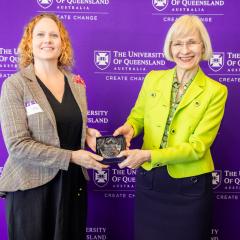The following article was published by UQ's Centre for Marine Science
‘Red tape’ – in the form of permitting restrictions – is hindering marine and coastal restoration projects across Australia, according to University of Queensland research.
The study, led by Associate Professor Justine Bell-James from UQ’s TC Beirne School of Law, found that legal permitting processes for restoration are often complex, expensive and time-consuming.
“For many restoration practitioners working in NGOs or research organisations, these hurdles can be insurmountable,” Dr Bell-James said.
“We found some practitioners turning away from sites with the highest restoration potential, and instead choosing sites based on the ease of obtaining permits.
“And, in some cases, restoration proponents are scaling down their ambition because of how complicated the permitting processes are.
“For example, they might have wanted to restore a site with some existing mangroves, as there are good scientific reasons to choose somewhere with existing vegetation.
“However, there are additional permits that might be needed to disturb marine plants, and applying for them would blow out the project timelines, therefore the proponent chose instead to restore a site with no vegetation, losing connectivity benefits.”
Data was collected by interviewing a small cohort of restoration practitioners, spanning a range of jurisdictions, project types, land tenures, and a variety of different organisation types.
Beyond initial permitting issues, the study revealed that progress is also being hampered by onerous post-approval conditions, including ongoing liability for restorative interventions.
The research also revealed that the permitting process stifles innovation and creativity as outcomes are locked-in at the permit stage.
Research collaborator and UQ PhD candidate Rose Foster said that there is urgent need to reform legal permitting processes for restoration, as current practice may put the achievement of global restoration targets at risk.
“To meet global restoration targets, action is needed at a large scale, and at a high level of ambition,” Ms Foster said.
“We’re currently subject to ambitious restoration targets internationally – restoring 30 per cent of degraded ecosystems by 2030.
“If proponents are forced to make compromises because of legal issues, these targets will be hard to meet.”
Dr Nicole Shumway, from UQ’s Centre for Policy Futures, said permitting needs to be designed specifically with restoration in mind, rather than just applying the same processes used for development like coal mine approvals.
“What reform will look like will be different from state to state and amongst project types, but needs to involve some streamlining to prioritise restoration,” Dr Shumway said.
“For example, lower-risk projects should be able to progress without every permit being needed.
“It’s critical that we act now, making it possible to reach our ambitious international targets.”
The research is published in Conservation Science and Practice.
Media: Associate Professor Justine Bell-James, j.bell-james@law.uq.edu.au, +61 3365 6588; Rose Foster, rose.foster@uq.edu.au, +61 417 043 796; Dr Nicole Shumway, n.shumway@uq.edu.au, +61 3443 3118; Faculty of Science Media, science.media@uq.edu.au, +61 438 162 687.



